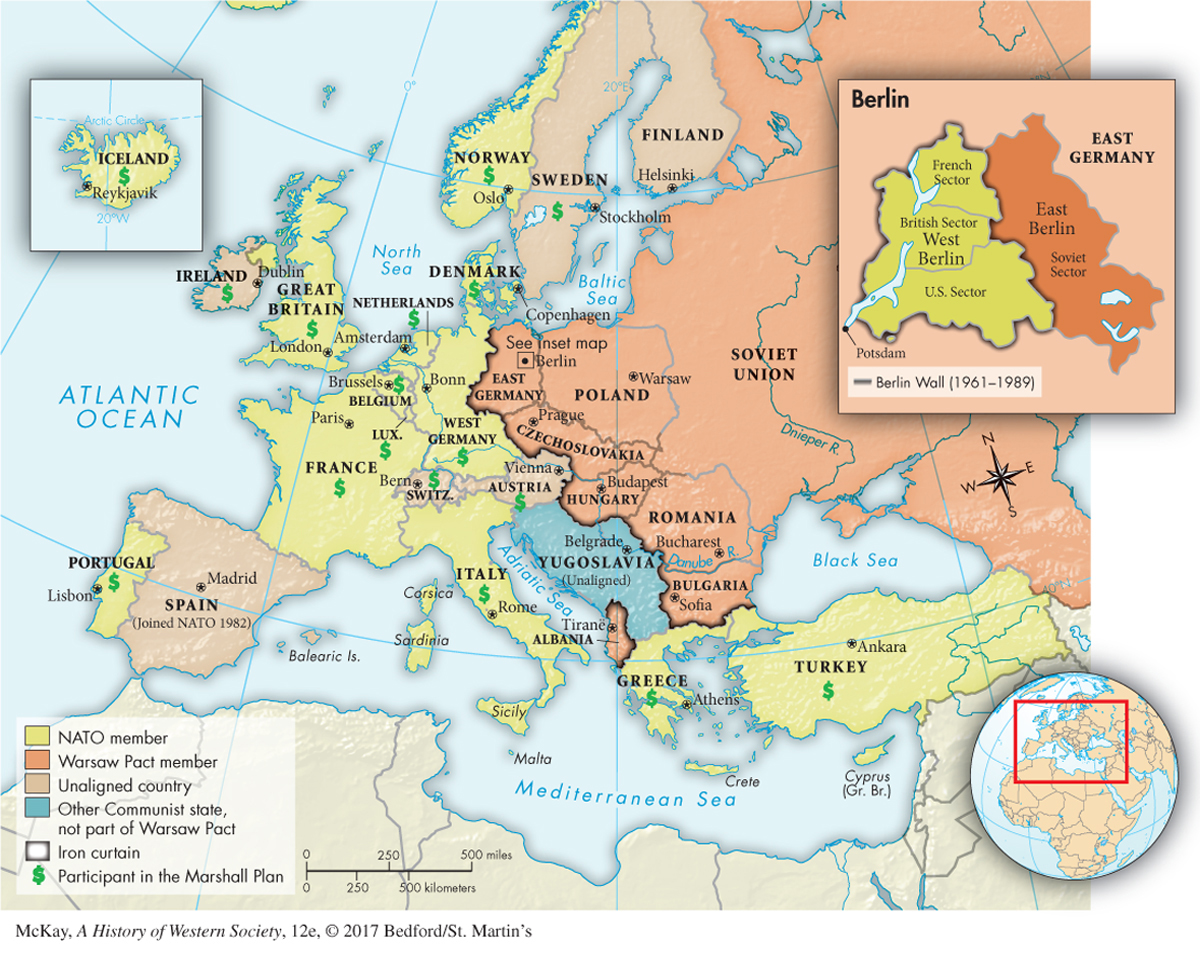West Versus East
The Cold War took shape over the next five years, as both sides hardened their positions. After Japan’s surrender in September 1945, Truman cut off aid to the ailing U.S.S.R. In October he declared that the United States would never recognize any government established by force against the will of its people. In March 1946 former British prime minister Churchill ominously informed an American audience that an “iron curtain” had fallen across the continent, dividing Europe into two antagonistic camps (Map 28.2).

The Soviet Union was indeed consolidating its hold on central and eastern Europe. In fact, the Soviets enjoyed some popular support in the region, though this varied from country to country. After all, the Red Army had thrown out the German invaders, and after the abuses of fascism the ideals of Communist equality retained some appeal. Yet the Communist parties in these areas quickly recognized that they lacked enough support to take power in free elections. In Romania, Bulgaria, Poland, and Hungary, Communist politicians, backed by Moscow, repressed their liberal opponents and engineered phony elections that established Communist-
In western Europe, communism also enjoyed some support. In Italy, which boasted the largest Communist Party outside of the Soviet bloc, Communists won 19 percent of the vote in 1946; French Communists earned 28 percent of the vote the same year. These large, well-
949
By early 1947 it appeared to many Americans that the U.S.S.R. was determined to export communism by subversion throughout Europe and around the world. The United States responded with the Truman Doctrine, aimed at “containing” communism to areas already under Communist governments, a policy first advocated by U.S. diplomat George Kennan in 1946. The United States, President Truman promised, would use diplomatic, economic, and even military means to resist the expansion of communism anywhere on the globe. In the first examples of containment policies in action, Truman asked Congress to provide military aid to anticommunist forces in the Greek Civil War (1944–1949) and counter the threat of Soviet expansion in Turkey. With American support, both countries remained in the Western bloc. The American determination to enforce containment hardened when the Soviets exploded their own atomic bomb in 1949, raising popular fears of a looming nuclear holocaust. At home and abroad, the United States engaged in an anticommunist crusade. Emotional, moralistic denunciations of Stalin and Communist regimes became part of American public life. By the early 1950s the U.S. government was restructuring its military to meet the Soviet threat, pouring money into defense spending, and testing nuclear weapons that dwarfed the destructive power of atomic bombs.
Military aid and a defense buildup were only one aspect of Truman’s policy of containment. In 1947 western Europe was still on the verge of economic collapse. Food was scarce, inflation was high, and black markets flourished. Recognizing that an economically and politically stable western Europe would be an effective block against the popular appeal of communism, U.S. secretary of state George C. Marshall offered Europe economic aid — the Marshall Plan — to help it rebuild. As Marshall wrote in a State Department bulletin, “Its purpose should be the revival of a working economy in the world so as to permit the emergence of political and social conditions in which free institutions can exist.”3
The Marshall Plan was one of the most successful foreign aid programs in history. When it ended in 1951, the United States had given about $13 billion in aid (equivalent to over $200 billion in 2015 dollars) to fifteen western European nations, and Europe’s economy was on the way to recovery. Marshall Plan funding was initially offered to East Bloc countries as well, but fearing Western interference in the Soviet sphere, they rejected the offer. In 1949 the Soviets established the Council for Mutual Economic Assistance (COMECON), an economic organization of Communist states intended to rebuild the East Bloc independently of the West. Thus the generous aid of the Marshall Plan was limited to countries in the Western bloc, which further increased Cold War divisions.
950
In the late 1940s Berlin, the capital city of Germany, was on the frontline of the Cold War. Like the rest of Germany and Austria, Berlin had been divided into four zones of occupation. In June 1948 the Western allies replaced the currency in the western zones of Germany and Berlin, an early move in plans to establish a separate West German state sympathetic to U.S. interests. The currency reform violated the peace settlement and raised Stalin’s fears of the American presence in Europe. In addition, growing ties among Britain, France, Belgium, and the Netherlands convinced Stalin that a Western bloc was forming against the Soviet Union. In response, the Soviet dictator used the one card he had to play — access to Berlin — to force the allies to the bargaining table. Stalin blocked all traffic through the Soviet zone of Germany to Berlin in an attempt to win concessions and perhaps reunify the city under Soviet control. Acting firmly, the Western allies coordinated around-
Success in breaking the Berlin blockade had several lasting results. First, it paved the way for the creation of two separate German states in 1949: the Federal Republic of Germany (West Germany), aligned with the United States, and the German Democratic Republic (East Germany), aligned with the U.S.S.R. Germany would remain divided for the next forty-
The Berlin crisis also seemed to show that containment worked, and thus strengthened U.S. resolve to maintain a strong European and U.S. military presence in western Europe. In 1949 the United States formed NATO (the North Atlantic Treaty Organization), an anti-
The superpower confrontation that emerged from the ruins of World War II took shape in Europe, but it quickly spread around the globe. The Cold War turned hot in East Asia. When Soviet-
By 1955 the Soviet-